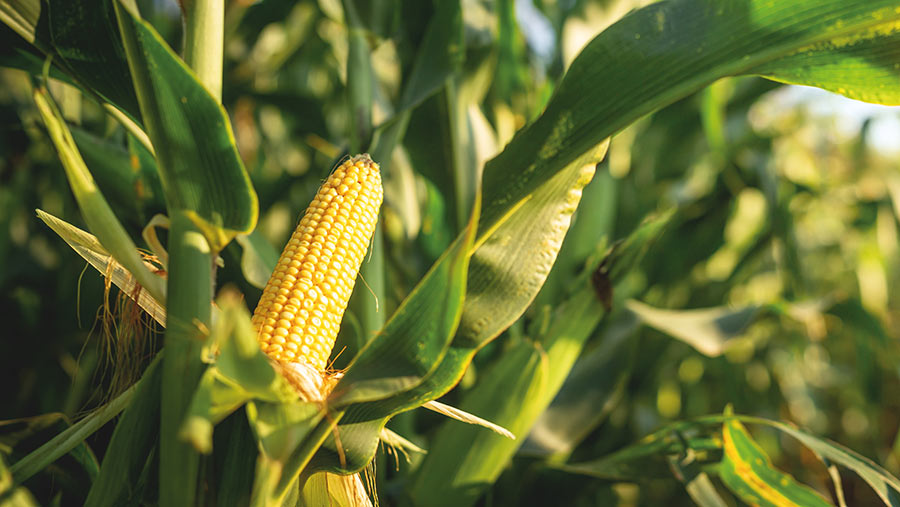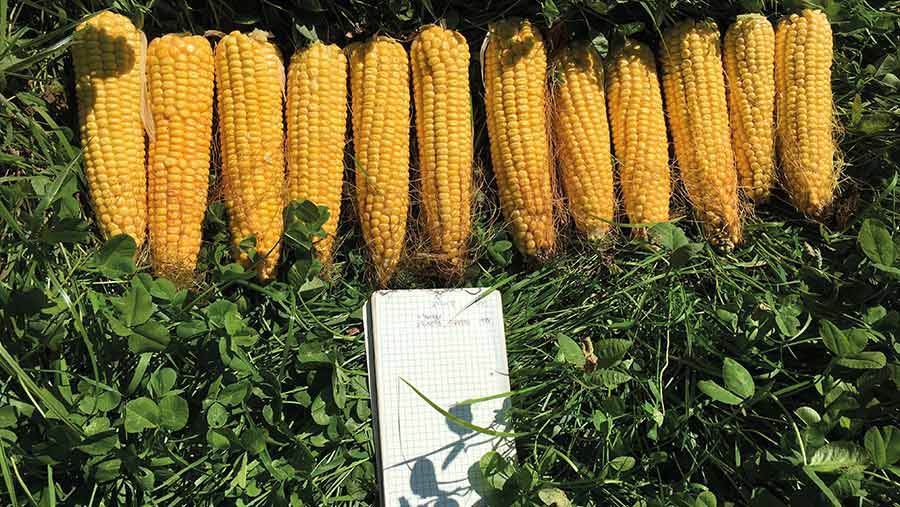Why shallow cultivations are best option in Cornish maize trial
 © Taras Rudenko/Adobe Stock
© Taras Rudenko/Adobe Stock With maize often criticised for its high environmental cost, Cornish farmers Malcolm and Catherine Barrett were keen to find ways to improve the sustainability of their operations.
They decided to set up a series of on-farm trials to better understand the effects of different maize establishment methods.
The couple farm 134ha (330 acres) at Tregooden Farm, St Tudy, operating a mixed beef and arable system, with 150 head of cattle, and wheat, barley, maize and cover crops grown.
See also: How growers can produce maize and protect environment
The trials, carried out over the spring and summer of 2022, compared three ways of establishing maize:
- Conventional (ploughed, power-harrowed and drilled)
- Shallow cultivated, using only a Horsch Sumo cultivator before drilling
- Direct-sown, using just a Mzuri direct drill.
The three methods were trialled in two fields – one after wheat and the other after a grass clover ley, with the grass sprayed off before the maize was sown.
Mr Barrett says the objective was to determine which method was the most cost-effective considering maize yield, quality and operations; which best supported improved soil health and reduced emissions; and which would be of most benefit to the following crop (spring barley).
Data analysis was carried out by Hannah Jones of Farm Carbon Toolkit. Here, she and the Barretts explain the key findings to date.
Farm facts
Tregooden Farm, St Tudy, Cornwall
- 134ha (330 acres) split 50:50 between grassland and arable
- Grows winter wheat, winter and spring barley and maize, followed by a cover crop after winter cereals
- 150-head beef herd
- Buys in dairy-cross calves and sells as stores at 18 months
- Cattle sold through Hallworthy Market
- Focus farm for the Duchy of Cornwall’s Natural Capital project

Malcolm and Catherine Barrett © Imogen Barrett
Crop performance
Cob weight and quality analysis were the parameters used to assess crop performance across the two treatment groups.
This quality analysis was only available for the maize drilled after grass (see “Maize quality after grass at Tregooden Farm”) and overall yield data were also limited owing to logistics with the weighing trailers.
What the Barretts did observe, however, was that the conventionally drilled maize produced smaller cobs than the other two treatment groups after both grass and wheat.
The Sumo-cultivated and direct-drilled maize also offered better digestibility, energy, starch and protein content than the conventional crop.
Soil health
Soil health was assessed using indicators including soil stability, worm numbers and water infiltration.
Results showed that conventional establishment resulted in less-stable soils with a higher incidence of slaking (where dry soil disintegrates into smaller lumps on wetting).
Where maize had been established via the Sumo and direct drill, worm numbers after grass were three times higher – and after wheat were twice as high – as those found where the plough had been used.
Despite being sprayed off in the spring, a significant amount of white clover reappeared in the maize crop sown after grass in both the Sumo and direct-drilled treatment groups.
Ms Jones says the only way to determine the benefits of this clover will be to assess the following crop next year to further examine how it may affect available nitrogen.

© Hannah Jones
Soil carbon
Soil carbon was measured as a snapshot in September 2022. According to the analysis, 0.5-0.6% less carbon was lost when maize was direct-drilled or Sumo-drilled after grass, compared with the conventional treatment.
After wheat, the analysis was more complex, but showed that where the Sumo was used, the most organic matter was evident – between 10-30cm in depth.
Ms Jones says less surface trash was visible in this treatment, and this could be down to more organic material being incorporated into the soil.
Total carbon footprint
Various carbon-related factors were analysed, including fuel use, which was lowest where the direct drill was used.
Fuel use here averaged 0.04t carbon dioxide equivalent (CO2e), compared with 0.19t CO2e in the conventional treatment and 0.10t CO2e in the Sumo treatment.
It is important to note, however, that yield was estimated to be less in the direct-drilled treatment.
Next steps
While the Barretts are planning to continue to tweak establishment methods at Tregooden, their findings so far will feed into a bigger research project facilitated by Farm Net Zero and Innovative Farmers.
Known as a field lab, the two-year trial will use farms in east and mid-Cornwall to get a better understanding of the benefits of different establishment methods and how they affect maize growth and yield, as well as soil health and erosion, explains Ms Jones.
Tregooden Farm maize trials summary
- The carbon footprint was lowest where the Sumo was used
- Soil health was improved where the direct drill and the Sumo were used
- Dry matter (DM) content was, on average, 3% lower in the Sumo and conventional treatment groups, compared with direct-drilled maize
- However, quality (digestibility, energy and starch) was better when maize had been either direct-drilled or drilled with the Sumo
- Though reduced DM has a cost, in the Sumo treatment group this was balanced by the benefits of improved soil health and cob weight, which make it a financially viable option for the Barretts
Maize quality after grass at Tregooden Farm |
|||
|
|
Conventional |
Sumo cultivator |
Direct-drilled |
|
Digestibility value (%) |
63 |
70 |
69 |
|
Metabolisable energy (MJ/kg) |
10.3 |
11.5 |
11.2 |
|
Neutral detergent fibre (g/kg) |
423 |
397 |
380 |
|
Starch (g/kg) |
353 |
351 |
330 |
|
Bypass starch (g/kg) |
125 |
124 |
109 |
|
Dry matter (%) |
27.1 |
27.2 |
30.7 |
|
pH |
3.9 |
3.8 |
3.8 |
|
Crude protein (g/kg) |
64 |
76 |
78 |
|
Source: Farm Carbon Toolkit on behalf of Farm Net Zero |
|||
Fuel costings at Tregooden Farm |
|||
|
Establishment method |
Operations |
Fuel use (litre/ha) |
Fuel cost (£/ha)* |
|
Conventional |
Plough, power harrow, drill |
56 |
60 |
|
Sumo cultivator |
Sumo cultivator, drill |
31 |
33 |
|
Direct sown |
Direct drill |
12 |
13 |
|
*Based on derv price of 107.4p/litre |
|||
